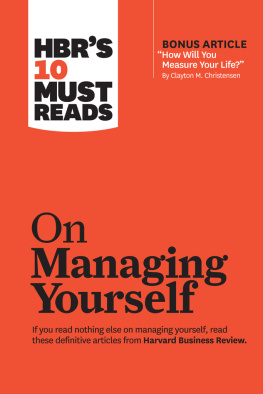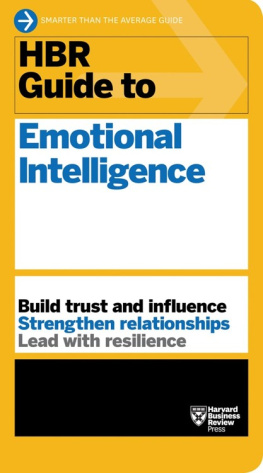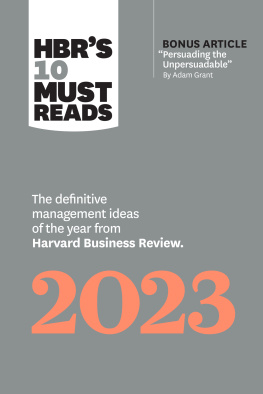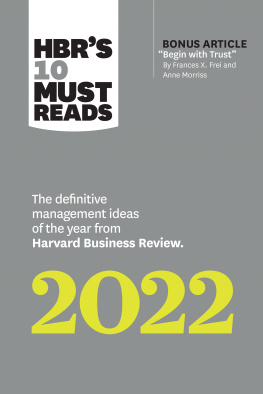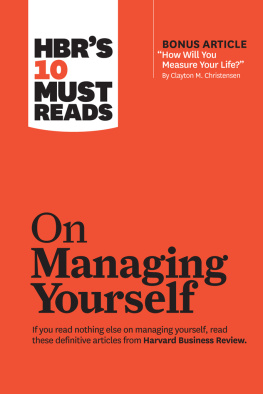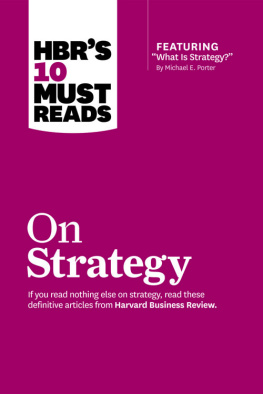Harvard Business Review - HBRs 10 Must Reads for Executives 8-Volume Collection
Here you can read online Harvard Business Review - HBRs 10 Must Reads for Executives 8-Volume Collection full text of the book (entire story) in english for free. Download pdf and epub, get meaning, cover and reviews about this ebook. year: 2021, publisher: Lightning Source Inc. (Tier 2), genre: Business. Description of the work, (preface) as well as reviews are available. Best literature library LitArk.com created for fans of good reading and offers a wide selection of genres:
Romance novel
Science fiction
Adventure
Detective
Science
History
Home and family
Prose
Art
Politics
Computer
Non-fiction
Religion
Business
Children
Humor
Choose a favorite category and find really read worthwhile books. Enjoy immersion in the world of imagination, feel the emotions of the characters or learn something new for yourself, make an fascinating discovery.
- Book:HBRs 10 Must Reads for Executives 8-Volume Collection
- Author:
- Publisher:Lightning Source Inc. (Tier 2)
- Genre:
- Year:2021
- Rating:4 / 5
- Favourites:Add to favourites
- Your mark:
- 80
- 1
- 2
- 3
- 4
- 5
HBRs 10 Must Reads for Executives 8-Volume Collection: summary, description and annotation
We offer to read an annotation, description, summary or preface (depends on what the author of the book "HBRs 10 Must Reads for Executives 8-Volume Collection" wrote himself). If you haven't found the necessary information about the book — write in the comments, we will try to find it.
Harvard Business Review: author's other books
Who wrote HBRs 10 Must Reads for Executives 8-Volume Collection? Find out the surname, the name of the author of the book and a list of all author's works by series.
HBRs 10 Must Reads for Executives 8-Volume Collection — read online for free the complete book (whole text) full work
Below is the text of the book, divided by pages. System saving the place of the last page read, allows you to conveniently read the book "HBRs 10 Must Reads for Executives 8-Volume Collection" online for free, without having to search again every time where you left off. Put a bookmark, and you can go to the page where you finished reading at any time.
Font size:
Interval:
Bookmark:

HBRs 10 Must Reads for Executives 8-Volume Collection
Contents
Harvard Business Review Press
Boston, Massachusetts

HBRs 10 Must Reads series is the definitive collection of ideas and best practices for aspiring and experienced leaders alike. These books offer essential reading selected from the pages of Harvard Business Review on topics critical to the success of every manager.
Titles include:
HBRs 10 Must Reads 2015
HBRs 10 Must Reads 2016
HBRs 10 Must Reads 2017
HBRs 10 Must Reads 2018
HBRs 10 Must Reads 2019
HBRs 10 Must Reads for New Managers
HBRs 10 Must Reads on AI, Analytics, and the New Machine Age
HBRs 10 Must Reads on Change Management
HBRs 10 Must Reads on Collaboration
HBRs 10 Must Reads on Communication
HBRs 10 Must Reads on Emotional Intelligence
HBRs 10 Must Reads on Entrepreneurship and Startups
HBRs 10 Must Reads on Innovation
HBRs 10 Must Reads on Leadership
HBRs 10 Must Reads on Leadership for Healthcare
HBRs 10 Must Reads on Leadership Lessons from Sports
HBRs 10 Must Reads on Making Smart Decisions
HBRs 10 Must Reads on Managing Across Cultures
HBRs 10 Must Reads on Managing People
HBRs 10 Must Reads on Managing Yourself
HBRs 10 Must Reads on Mental Toughness
HBRs 10 Must Reads on Sales
HBRs 10 Must Reads on Strategic Marketing
HBRs 10 Must Reads on Strategy
HBRs 10 Must Reads on Strategy for Healthcare
HBRs 10 Must Reads on Teams
HBRs 10 Must Reads on Women and Leadership
HBRs 10 Must Reads: The Essentials
HBR Press Quantity Sales Discounts
Harvard Business Review Press titles are available at significant quantity discounts when purchased in bulk for client gifts, sales promotions, and premiums. Special editions, including books with corporate logos, customized covers, and letters from the company or CEO printed in the front matter, as well as excerpts of existing books, can also be created in large quantities for special needs.
For details and discount information for both print and ebook formats, contact .
Copyright 2019 Harvard Business School Publishing Corporation
All rights reserved
No part of this publication may be reproduced, stored in or introduced into a retrieval system, or transmitted, in any form, or by any means (electronic, mechanical, photocopying, recording, or otherwise), without the prior permission of the publisher. Requests for permission should be directed to , or mailed to Permissions, Harvard Business School Publishing, 60 Harvard Way, Boston, Massachusetts 02163.
First eBook Edition: Apr 2019
ISBN: 9781633697157
eISBN: 9781633697164
THE OIL INDUSTRY HOLDS RELATIVELY few surprises for strategists. Things change, of course, sometimes dramatically, but in relatively predictable ways. Planners know, for instance, that global supply will rise and fall as geopolitical forces play out and new resources are discovered and exploited. They know that demand will rise and fall with incomes, GDPs, weather conditions, and the like. Because these factors are outside companies and their competitors control and barriers to entry are so high, no one is really in a position to change the game much. A company carefully marshals its unique capabilities and resources to stake out and defend its competitive position in this fairly stable firmament.
The internet software industry would be a nightmare for an oil industry strategist. Innovations and new companies pop up frequently, seemingly out of nowhere, and the pace at which companies can buildor losevolume and market share is head-spinning. A major player like Microsoft or Google or Facebook can, without much warning, introduce some new platform or standard that fundamentally alters the basis of competition. In this environment, competitive advantage comes from reading and responding to signals faster than your rivals do, adapting quickly to change, or capitalizing on technological leadership to influence how demand and competition evolve.
When the Cold Winds Blow
THERE ARE CIRCUMSTANCES in which none of our strategic styles will work well: when access to capital or other critical resources is severely restricted, by either a sharp economic downturn or some other cataclysmic event. Such a harsh environment threatens the very viability of a company and demands a fifth strategic stylesurvival.
As its name implies, a survival strategy requires a company to focus defensivelyreducing costs, preserving capital, trimming business portfolios. It is a short-term strategy, intended to clear the way for the company to live another day. But it does not lead to any long-term growth strategy. Companies in survival mode should therefore look ahead, readying themselves to assess the conditions of the new environment and to adopt an appropriate growth strategy once the crisis ends.
Clearly, the kinds of strategies that would work in the oil industry have practically no hope of working in the far less predictable and far less settled arena of internet software. And the skill sets that oil and software strategists need are worlds apart as well, because they operate on different time scales, use different tools, and have very different relationships with the people on the front lines who implement their plans. Companies operating in such dissimilar competitive environments should be planning, developing, and deploying their strategies in markedly different ways. But all too often, our research shows, they are not.
That is not for want of trying. Responses from a recent BCG survey of 120 companies around the world in 10 major industry sectors show that executives are well aware of the need to match their strategy-making processes to the specific demands of their competitive environments. Still, the survey found, in practice many rely instead on approaches that are better suited to predictable, stable environments, even when their own environments are known to be highly volatile or mutable.
Whats stopping these executives from making strategy in a way that fits their situation? We believe they lack a systematic way to go about ita strategy for making strategy. Here we present a simple framework that divides strategy planning into four styles according to how predictable your environment is and how much power you have to change it. Using this framework, corporate leaders can match their strategic style to the particular conditions of their industry, business function, or geographic market.
Companies that correctly match their strategy-making processes to their competitive circumstances perform better than those that dont. But too many use approaches appropriate only to predictable environmentseven in highly volatile situations.
What executives in these cases need is a strategy for setting strategy. The authors present a framework for choosing one, which begins with two questions: How unpredictable is your environment? and How much power do you or others have to change that environment?
The answers give rise to four broad strategic styles, each one particularly suited to a distinct environment.
A classical strategy
Font size:
Interval:
Bookmark:
Similar books «HBRs 10 Must Reads for Executives 8-Volume Collection»
Look at similar books to HBRs 10 Must Reads for Executives 8-Volume Collection. We have selected literature similar in name and meaning in the hope of providing readers with more options to find new, interesting, not yet read works.
Discussion, reviews of the book HBRs 10 Must Reads for Executives 8-Volume Collection and just readers' own opinions. Leave your comments, write what you think about the work, its meaning or the main characters. Specify what exactly you liked and what you didn't like, and why you think so.




